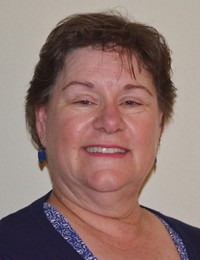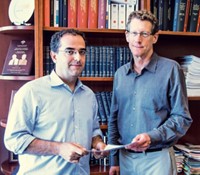Advertisement
Grab your lab coat. Let's get started
Welcome!
Welcome!
Create an account below to get 6 C&EN articles per month, receive newsletters and more - all free.
It seems this is your first time logging in online. Please enter the following information to continue.
As an ACS member you automatically get access to this site. All we need is few more details to create your reading experience.
Not you? Sign in with a different account.
Not you? Sign in with a different account.
ERROR 1
ERROR 1
ERROR 2
ERROR 2
ERROR 2
ERROR 2
ERROR 2
Password and Confirm password must match.
If you have an ACS member number, please enter it here so we can link this account to your membership. (optional)
ERROR 2
ACS values your privacy. By submitting your information, you are gaining access to C&EN and subscribing to our weekly newsletter. We use the information you provide to make your reading experience better, and we will never sell your data to third party members.
Awards
Lab Safety At The University Of California
System works to implement and improve upon legally mandated program to protect researchers
by Jyllian Kemsley
August 26, 2013
| A version of this story appeared in
Volume 91, Issue 34

One year ago, the University of California entered into a lab safety agreement with the Los Angeles County District Attorney’s Office. The agreement was the result of a 2008 laboratory fire at UC Los Angeles that led to the death of a chemistry staff researcher.
Prosecutors subsequently charged the largest university system in the U.S. as well as UCLA chemistry professor Patrick G. Harran with felony violations of the California labor code. As of C&EN press time, Harran was still facing trial on these charges, but the deal struck between the district attorney and UC meant that prosecutors dropped the charges against UC. In return, UC embarked on a prescribed safety program that involves administering lab safety training, enforcing personal protective equipment (PPE) policies, and documenting laboratory standard operating procedures (SOPs) in chemistry and biochemistry departments at all 10 UC campuses.
Timelines for UC to execute the agreement were tight: UCLA had to be compliant within three months, and the remaining campuses within six months. Implementation of the program was hampered in some places by lack of good personnel management systems, by poor laboratory layouts, and by the thousands of chemicals that needed SOPs. But the schools succeeded. Now, UC is focusing on going beyond the agreement, developing new training and PPE policies that apply to all laboratories—not just those in chemistry departments—as well as new tools to help all researchers work more safely.
“We have been trying to think globally in all our initiatives and to develop an improved laboratory safety culture throughout the UC system,” says Erike Young, director of environment, health, and safety (EH&S) for UC’s Office of the President. Some of the efforts are part of a 2010 strategic plan predating the legal settlement.
For training, the settlement requires that all principal investigators and laboratory personnel complete a general laboratory safety training program. The program must cover topics such as identification and evaluation of laboratory hazards, as well as university policies regarding responsibilities for laboratory safety at both supervisor and lab worker levels. The general training does not replace the need for more specific training related to equipment and procedures in individual laboratories.

Debbie M. Decker had worked in Safety Services at UC Davis, but in January she shifted to become its chemistry department’s safety manager. She had been doing the campus’s lab safety training for more than a decade when the settlement agreement emerged. Her existing training curriculum met the settlement’s requirements, she says.
The real challenge, she points out, was figuring out who needed the training. The school had implemented a computer system several years ago to track who was trained, but it is difficult to use, she says. Also, it was difficult to identify visiting scholars and some postdoctoral researchers as being part of the department, especially those who were paid by their home institutions. And although no one ever said it to Decker directly, some researchers seemed to think it was presumptuous of UC Davis to require training of experienced researchers from other institutions.
“There isn’t any wiggle room in the settlement; it’s very clear that everyone has to be trained,” Decker says. “Communicating that to some scholars and their hosts was a bit tricky.”
Other schools faced similar challenges. At UC Berkeley, “when my chancellor asked me how many people were in the College of Chemistry, I couldn’t answer,” said chemistry professor and former college dean Richard A. Mathies at a June meeting of a National Academy of Sciences (NAS) committee focused on academic lab safety. In the end, UC Berkeley trained about 900 people in a two-month period that included Thanksgiving, fall semester finals, and the winter holiday.
“That tells you something about the mind-set of students in the lab,” Mathies said. “When you give them something that makes sense and they believe it builds value, they’ll do it.” He conceded that a few members of the college still needed to be pushed to comply.
Going beyond settlement compliance, in June of this year, UC instituted a new systemwide policy that establishes minimum general training requirements for people working in all research, teaching, and analytical laboratories, as well as areas such as stock and storage rooms.
The training policy dictates that all workers, including faculty, must complete a general safety training program before being granted unescorted access to laboratories or technical areas. The general safety training must cover general safety culture, the campus chemical hygiene plan, hazard analysis and controls, personal protective equipment, emergency response, and rights and responsibilities. Training must be refreshed at least every three years.
In line with the new policy, UC also rolled out an online Laboratory Safety Fundamentals training program. Campuses may use the online training, conduct their own, or combine the two.
Production of the online program cost $40,000, Young says, and UC jointly owns the content with Vivid Learning Systems. Parts can be easily customized by other institutions, and Vivid Learning Systems expects to market it to other schools this fall, Young says.
Workers who do the online program must still go through a site-specific safety orientation that covers topics such as locations of eyewash stations and the laboratory safety manual, as well as training on the specific hazards and procedures of their workplace. UC is also working on a supplemental training program for supervisors, which Young expects to release this fall, as well as a management academy to help faculty and other supervisors better understand their responsibilities.
Components Of UC Systemwide Safety Training
1. Safety culture
2. Chemical hygiene plan
3. Hazard analysis: physical, chemical, biological, and radiological
4. Hazard controls: administrative, engineering, and personal protective equipment
5. Work performance: prudent practices, exposure recognition, and emergencies
6. Rights and responsibilities of workers and supervisors
SOURCE: UC Policy on Laboratory Safety Training, issued on June 12, 2013,http://policy.ucop.edu/doc/
3500598/LabSafetyTraining
A second main component of the settlement agreement involves PPE. The agreement sets out a minimum standard for anyone working in or occupying laboratory areas: full-length pants; fully closed shoes; lab coats, including flame-resistant coats for working with flammable liquids or pyrophoric materials; and appropriate gloves and eye protection for handling any hazardous chemical, biological, or radiological material. “Employees shall not bear the cost of any required PPE,” the agreement says, and departments are charged with the responsibility for laundering items as necessary.
Implementation of the PPE policy was fairly straightforward, some UC campus representatives say. “The chair of the safety committee told me that she sees all lab personnel wearing appropriate PPE now, no questions asked,” says Ilan Benjamin, chair of the chemistry and biochemistry department at UC Santa Cruz. At UCLA, which instituted many safety program changes before the settlement agreement, unannounced PPE inspections showed 94% compliance in 2012, up from 76% in 2011.
In some places, laboratory infrastructure created a challenge to meeting PPE requirements. Older buildings on many campuses combine desks and benches in the same space, raising the question of whether students really must wear lab coats and eye protection when sitting at their desks. Some labs responded by using hazard analysis to designate “clean” areas where PPE is not required and personnel may eat or drink, even though they’re technically in a lab.
Sometimes that required putting some thought into lab setup. UC San Diego chemistry department chair Seth M. Cohen, for example, relocated his lab’s rotovaps farther away from desks. His department is also working on installing Plexiglas barriers to better define and protect clean space.
Akin to the new systemwide training policy, in June, UC rolled out a new PPE policy that applies beyond chemistry laboratories to all labs or other technical areas, including teaching labs. The policy sets out minimum PPE standards similar to the settlement agreement. Faculty or other supervisors must also assess whether people performing laboratory work need additional specific PPE. UCLA chemistry professor and safety committee chair Craig A. Merlic is heading a project to develop his campus’s laboratory hazard assessment tool for systemwide PPE evaluation.
To enable researchers to comply with the new policy, UC purchased 135,000 pairs of protective eyewear, 10,000 face shields, and 115,000 lab coats, both flame-resistant and non-flame-resistant. The gear will be distributed later this year. Students enrolled in lab classes will have to buy their own.
The size of the PPE order enabled UC not just to reduce costs by buying in bulk, but also to solve one PPE problem plaguing female researchers: a lack of small-sized women’s coats from usual lab supply sources. UC custom ordered them.
A laundry service will clean lab coats, most likely including those purchased by students for lab classes. Young expects the laundry bills to be about $500,000 annually for the system. UC has spent $4 million so far procuring PPE for the settlement agreement and the new policy, Young says.
Policies, Training, And Other Tools
In a time of continued tight budgets postrecession, UC has the money to pay for PPE and other lab safety projects because it reduced the number of workplace injuries from 8,400 in 2004 to 5,000 in 2012. That in turn lowered UC’s annual workers compensation costs from $90 million to $40 million. The changes came by addressing things such as ergonomic problems and providing nonslip shoes for custodial, food service, physical plant, police, and landscaping employees, Young says.
A third major part of the settlement agreement required creating SOPs for a list of several thousand chemicals, including compounds that are pyrophoric, water reactive, potentially explosive, acutely toxic, corrosive, or oxidizing.
One challenge was the sheer number of chemicals covered. Another was the number of lab groups that needed to write the SOPs—more than 400. Some schools lacked a chemical inventory system capable of easily identifying and locating chemicals that needed SOPs. And then there was no clear regulatory guidance for what an SOP should look like. The California Code of Regulations merely says that chemical hygiene plans must include “standard operating procedures relevant to safety and health considerations to be followed when laboratory work involves the use of hazardous chemicals” (Title 8, Section 5191).
Eventually, UC was able to clarify that “control banding”—writing one SOP for a group of chemicals with similar properties and handling techniques—would satisfy authorities, reducing the magnitude of the task somewhat, Young says. UC researchers still wrote 7,000 SOPs and spent $2 million on consultants to help.
But questions continued about how detailed the SOPs needed to be, and there was no good way to share the procedures among lab groups doing similar tasks. The process was “not optimized for efficiency,” UCSC’s Benjamin says. SOP writing and updating continues to be a significant time commitment, he says.
Consequently, the project was not embraced by researchers. “It was rushed, it was not well planned, and it was viewed as inefficient and a process that had very poor value,” UC Berkeley’s Mathies said at the June NAS meeting. “It illustrates an important point, which is that safety is important, and you have to treat it seriously and present it to people in a manner that makes sense to them. When you present it to them in a silly way that’s an inefficient use of time, they develop a cynical attitude about safety, and that’s not what you want.”
As in other areas, UC is working systemwide to try to streamline the SOP-writing process and make it more useful by developing an online tool called RADiCAL (Risk Assessment Determinations in Chemical Academic Laboratories). The program will allow researchers to enter chemicals and their amounts used to determine whether an SOP already exists or they need to generate a new one. The system will then help generate new SOPs if necessary. It will also flag high-risk experiments for higher-level review.
Advertisement
RADiCAL may also find use in teaching labs. UC Merced’s School of Engineering is considering using it in its undergraduate curriculum—to have students generate SOPs as a prelab exercise, says instructional lab manager Mike Dunlap.
Whether compliance with the settlement agreement and new policies is actually helping researchers work more safely is an open question. It’s one thing to don proper protection and another to actually think through an experiment, its hazards, and how best to perform it. “Just wrapping people up in a lab coat and gloves doesn’t automatically make them safe,” UC Davis’ Decker says. “We’re not focusing, I think, enough on other controls.”
Department chairs, however, believe that things are improving. UCSD’s Cohen and UCSC’s Benjamin both see increased awareness in their departments. “The huge majority of researchers and research mentors are truly taking lab safety to heart, both in working more safely and planning to make the lab a safer place,” Benjamin says.
“On a regular basis, I field technical questions about safety,” UCLA’s Merlic says. He gives examples: “EH&S wants my waste bottle capped, but I know it is outgassing, so I want to keep it open for 24 hours. How should I handle it?” “I used to wear short-sleeved shirts when working on the laser, but now with a lab coat on I worry about my sleeve moving a mirror, which could be hazardous.”
As for where everyone goes from here, after a year of new programs, policies, and hard work, “what we have to do is not drop the ball or let our guard down,” says Samuel J. Traina, UC Merced’s vice chancellor for research. “We have to maintain not frenetic activity but a focus on safety.”





Join the conversation
Contact the reporter
Submit a Letter to the Editor for publication
Engage with us on Twitter